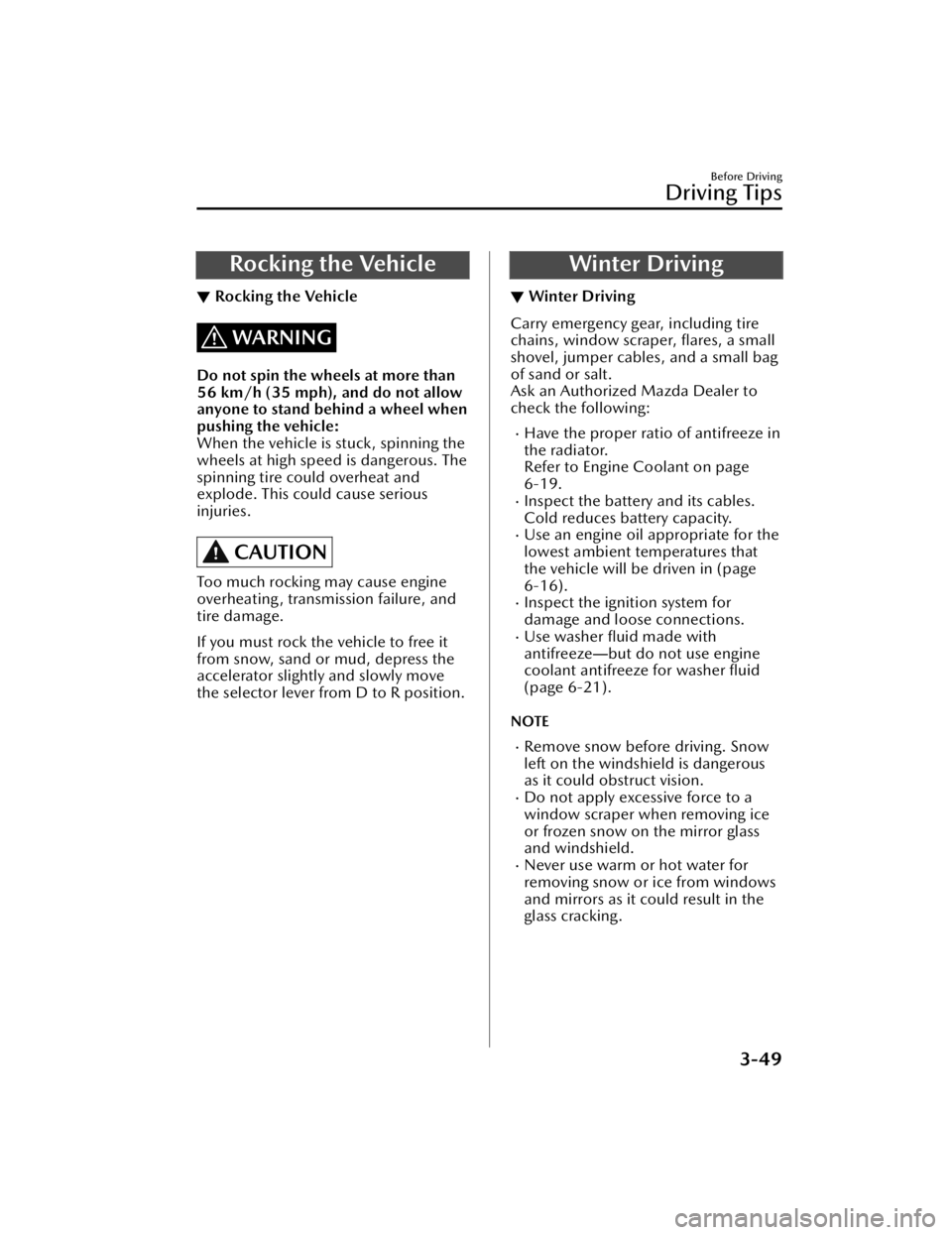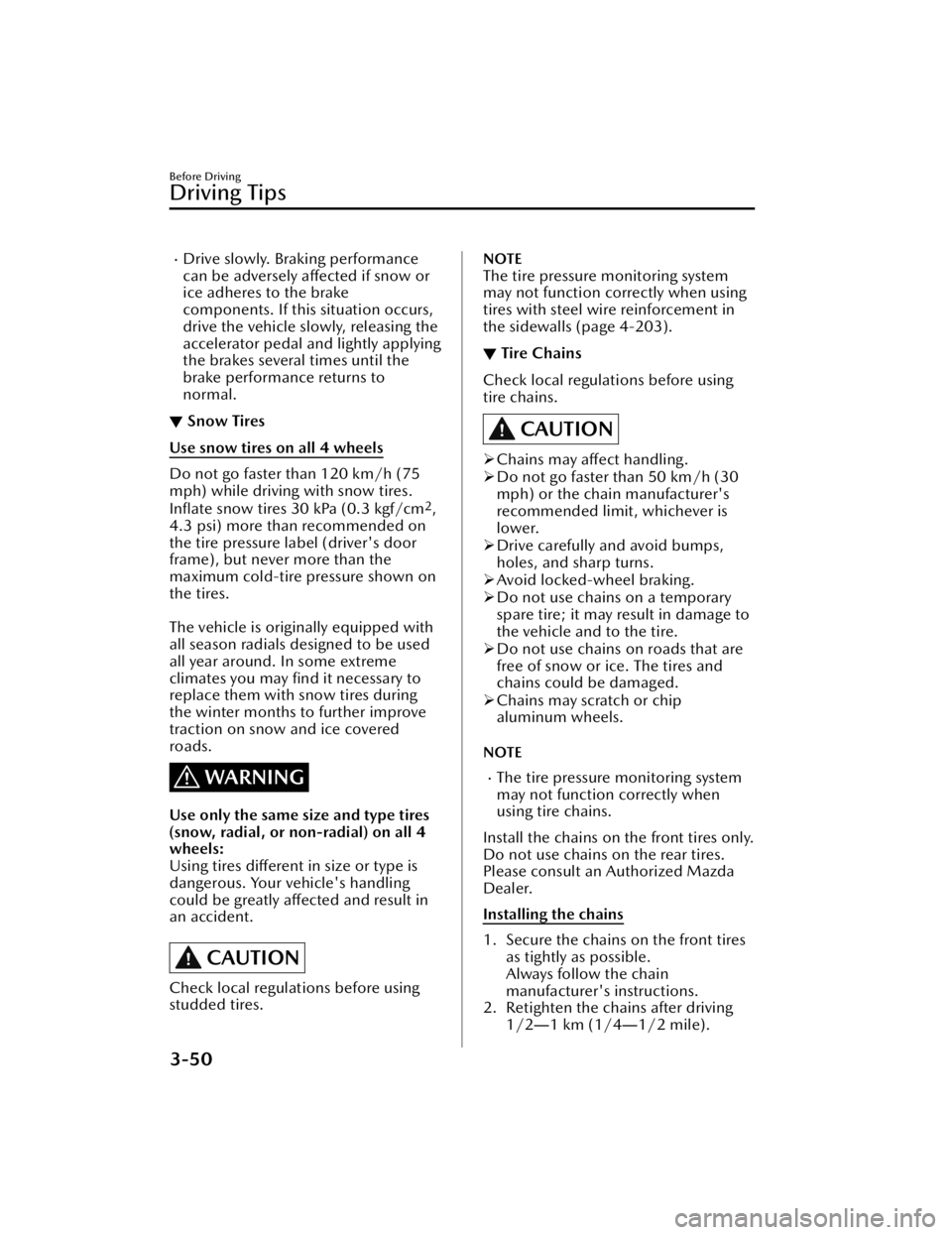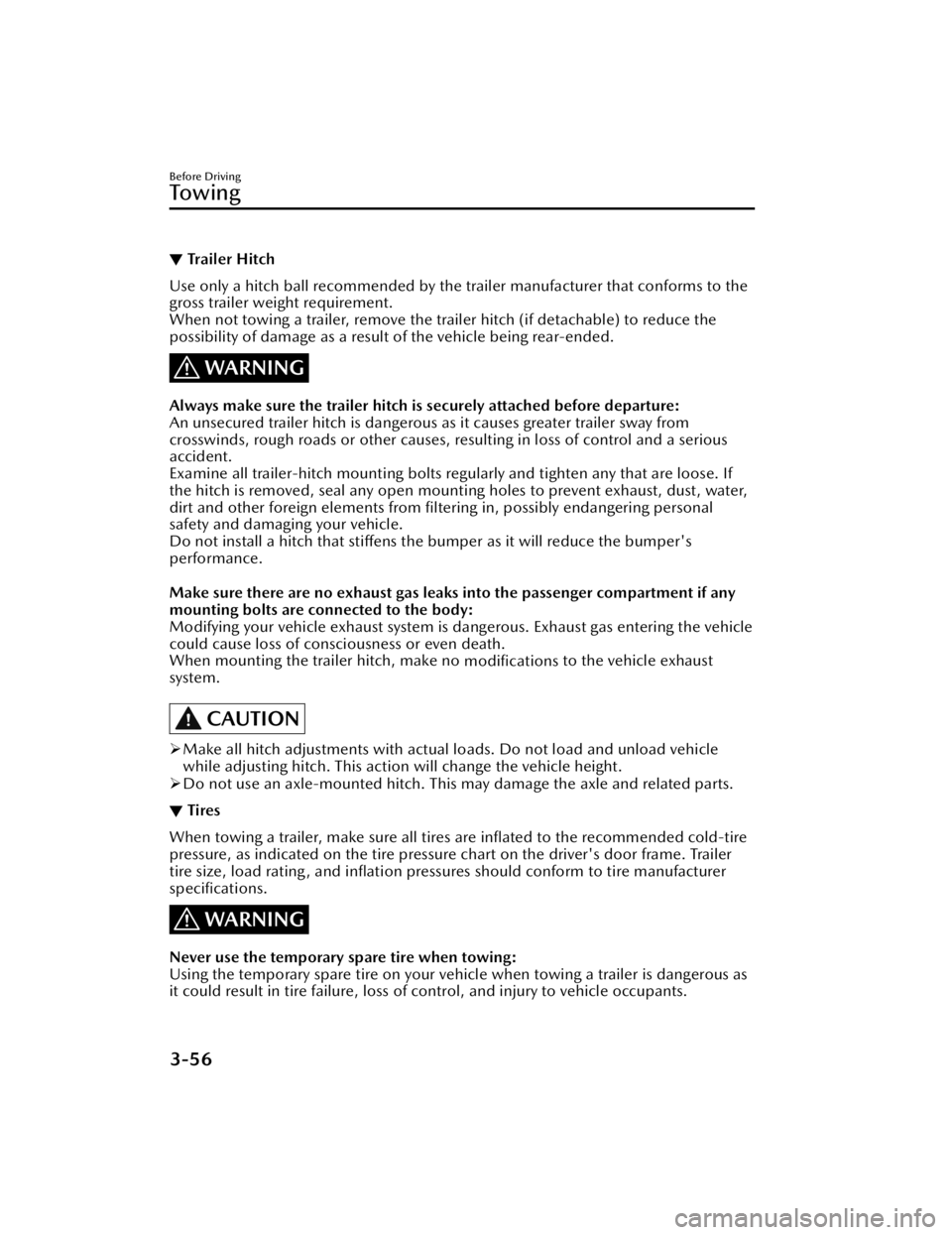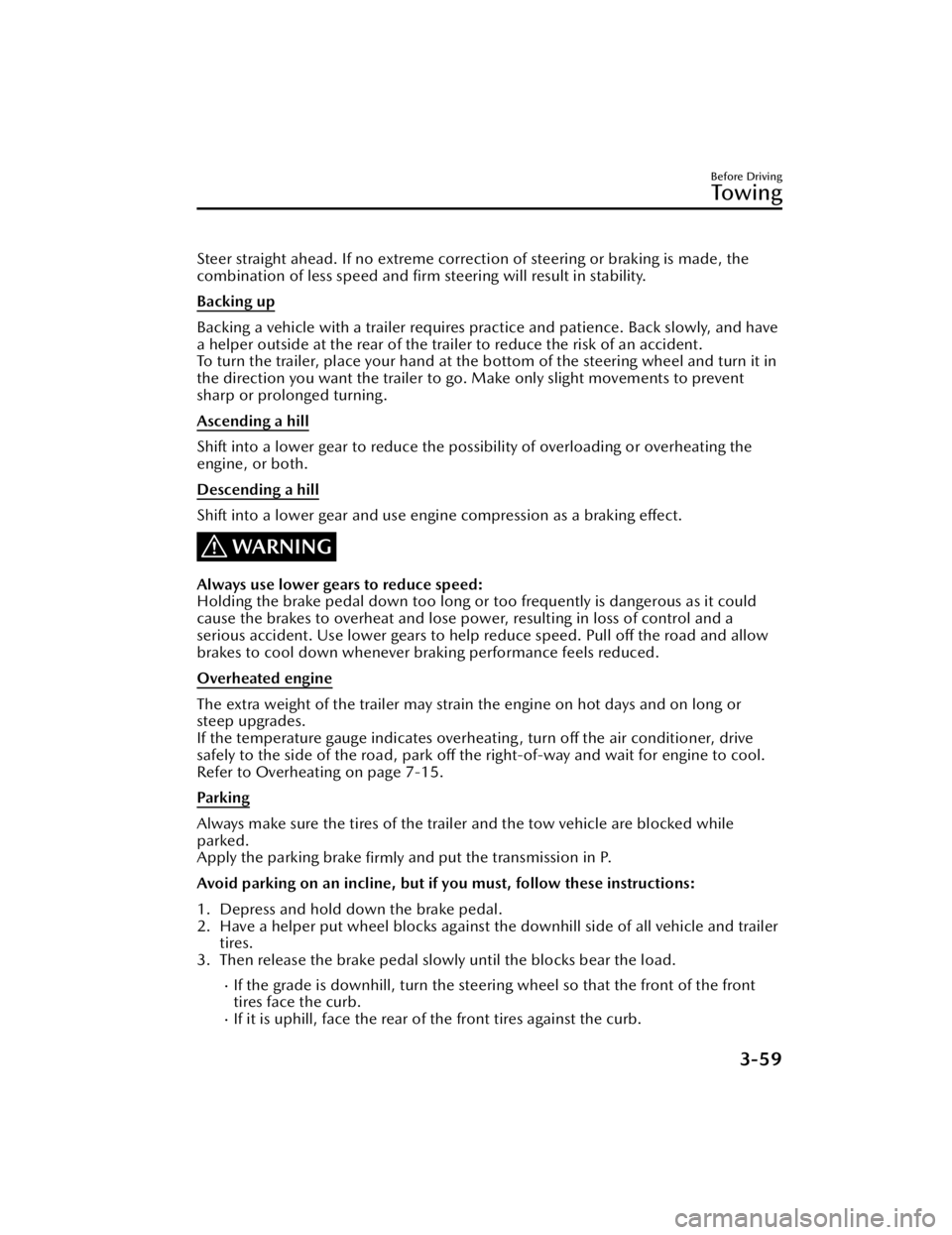warning MAZDA MODEL CX-50 2023 Repair Manual
[x] Cancel search | Manufacturer: MAZDA, Model Year: 2023, Model line: MODEL CX-50, Model: MAZDA MODEL CX-50 2023Pages: 583, PDF Size: 85.63 MB
Page 137 of 583

Avoid sudden braking and sudden
maneuvering.
Do not pump the brakes. Continue
to press down on the brake pedal.
Refer to Antilock Brake System (ABS)
on page 4-78.
If you get stuck, select a lower gear
and accelerate slowly. Do not spin
the front wheels.
For more traction in starting on
slippery surfaces such as ice or
packed snow, use sand, rock salt,
chains, carpeting, or other nonslip
material under the front wheels.
NOTE
Use snow chains only on the front
wheels.
Floor Mat
▼Floor Mat
We recommend the use of Genuine
Mazda
floor mats.
WARNING
Make sure the
floor mats are hooked
on the retention pins to prevent them
from bunching up under the foot
pedals:
Using a floor mat that is not secured is
dangerous as it will interfere with the
accelerator and brake pedal operation,
which could result in an accident.
Do not install two floor mats, one on
top of the other, on the driver's side:
Installing two floor mats, one on top of
the other, on the driver's side is
dangerous as the retention pins can
only keep one floor mat from sliding
forward.
Loose floor mat(s) will interfere with
the foot pedals and could result in an
accident.
If using an all-weather mat for winter
use always remove the original floor
mat.
When setting a floor mat, position the
floor mat so that its grommets are
inserted over the pointed end of the
retention posts.
Before Driving
Driving Tips
3-48
CX-50_8KB8-EA-22A_Edition2_new 2022-1-6 14:55:18
Page 138 of 583

Rocking the Vehicle
▼Rocking the Vehicle
WARNING
Do not spin the wheels at more than
56 km/h (35 mph), and do not allow
anyone to stand behind a wheel when
pushing the vehicle:
When the vehicle is stuck, spinning the
wheels at high speed is dangerous. The
spinning tire could overheat and
explode. This could cause serious
injuries.
CAUTION
Too much rocking may cause engine
overheating , transmission failure, and
tire damage.
If you must rock the vehicle to free it
from snow, sand or mud, depress the
accelerator slightly and slowly move
the selector lever from D to R position.
Winter Driving
▼Winter Driving
Carry emergency gear, including tire
chains, window scraper,
flares, a small
shovel, jumper cables, and a small bag
of sand or salt.
Ask an Authorized Mazda Dealer to
check the following:
Have the proper ratio of antifreeze in
the radiator.
Refer to Engine Coolant on page
6-19.
Inspect the battery and its cables.
Cold reduces battery capacity.
Use an engine oil appropriate for the
lowest ambient temperatures that
the vehicle will be driven in (page
6-16).
Inspect the ignition system for
damage and loose connections.
Use washer fluid made with
antifreeze ―but do not use engine
coolant antifreeze for washer fluid
(page 6-21).
NOTE
Remove snow before driving. Snow
left on the windshield is dangerous
as it could obstruct vision.
Do not apply excessive force to a
window scraper when removing ice
or frozen snow on the mirror glass
and windshield.
Never use warm or hot water for
removing snow or ice from windows
and mirrors as it could result in the
glass cracking.
Before Driving
Driving Tips
3-49
CX-50_8KB8-EA-22A_Edition2_new 2022-1-6 14:55:18
Page 139 of 583

Drive slowly. Braking performance
can be adversely affected if snow or
ice adheres to the brake
components. If this situation occurs,
drive the vehicle slowly, releasing the
accelerator pedal and lightly applying
the brakes several times until the
brake performance returns to
normal.
▼ Snow Tires
Use snow tires on all 4 wheels
Do not go faster than 120 km/h (75
mph) while driving with snow tires.
Inflate
snow tires 30 kPa (0.3 kgf/cm
2,
4.3 psi) more than recommended on
the tire pressure label (driver's door
frame), but never more than the
maximum cold-tire pressure shown on
the tires.
The vehicle is orig inally equipped with
all season radials designed to be used
all year around. In some extreme
climates you may find it necessary to
replace them with snow tires during
the winter months to further improve
traction on snow and ice covered
roads.
WARNING
Use only the same size and type tires
(snow, radial, or non-radial) on all 4
wheels:
Using tires different in size or type is
dangerous. Your vehicle's handling
could be greatly affected and result in
an accident.
CAUTION
Check local regulations before using
studded tires.
NOTE
The tire pressure monitoring system
may not function correctly when using
tires with steel wire reinforcement in
the sidewalls (page 4-203).
▼ Tire Chains
Check local regulations before using
tire chains.
CAUTION
Chains may affect handling.
Do not go faster than 50 km/h (30
mph) or the chain manufacturer's
recommended limit, whichever is
lower.
Drive carefully and avoid bumps,
holes, and sharp turns.
Avoid locked-wheel braking.
Do not use chains on a temporary
spare tire; it may result in damage to
the vehicle and to the tire.
Do not use chains on roads that are
free of snow or ice. The tires and
chains could be damaged.
Chains may scratch or chip
aluminum wheels.
NOTE
The tire pressure monitoring system
may not function correctly when
using tire chains.
Install the chains on the front tires only.
Do not use chains on the rear tires.
Please consult an Authorized Mazda
Dealer.
Installing the chains
1. Secure the chains on the front tires as tightly as possible.
Always follow the chain
manufacturer's instructions.
2. Retighten the chains after driving 1/2 ―1 km (1/4 ―1/2 mile).
Before Driving
Driving Tips
3-50
CX-50_8KB8-EA-22A_Edition2_new 2022-1-6 14:55:18
Page 140 of 583

Driving In Flooded Area
▼Driving In Flooded Area
WARNING
Dry off brakes that have become wet
by driving slowly, releasing the
accelerator pedal and lightly applying
the brakes several times until the
brake performance returns to normal:
Driving with wet brakes is dangerous.
Increased stopping distance or the
vehicle pulling to one side when
braking could result in a serious
accident. Light braking will indicate
whether the brakes have been
affected.
CAUTION
Do not drive the vehicle on flooded
roads as it could cause short circuiting
of electrical/electronic parts, or engine
damage or stalling from water
absorption. If the vehicle has been
immersed in water, consult an
Authorized Mazda Dealer.
Overloading
▼Overloading
WARNING
Be careful not to overload your
vehicle:
The gross axle weight rating (GAWR)
and the gross vehicle weight rating
(GVWR) of the vehicle are on the
Motor Vehicle Safety Standard Label
on the driver's door frame. Exceeding
these ratings can cause an accident or
vehicle damage. You can estimate the
weight of the load by weighing the
items (or people) before putting them
in the vehicle.
Before Driving
Driving Tips
3-51
CX-50_8KB8-EA-22A_Edition2_new
2022-1-6 14:55:18
Page 144 of 583

ItemModel
SKYACTIV-G 2.5 SKYACTIV-G
2.5T
FWD AWD AWD
TRAIL-
ER-TONGUE
LOAD To n g u e l o a d
Tongue load/Trailer load × 100 = 10 % to 15 %
Trailer load
DISTRIBUTION
OF TRAILER
LOADFront 60 %
Rear 40 %
WARNING
Always keep tow loads within
specified limits as indicated in the Trailer
To w i n g - L o a d Ta b l e :
Attempting to tow loads greater than those specified is dangerous as it may cause
serious handling and performance problems that could result in personal injury or
vehicle damage, or both.
Load your trailer with the weight about 60 % toward the front and 40 % toward
the rear:
Loading the trailer with more weight in the rear than in the front is dangerous. Doing
so could cause you to lose control. The trailer tongue load must be 10 % ―15 % of
the total trailer load (sum of the weights of the trailer and cargo).
Always have the total trailer weight and tongue load determined prior to
departure:
Attempting to tow loads without determining the total trailer weight and tongue
load is dangerous. Trailer sway from crosswinds, rough roads or other causes could
result in loss of control and a serious accident.
CAUTION
The total trailer weight and tongue load ca n be determined by weighing the trailer
on platform scales at a highway we ight station or a trucking company.
Before Driving
Towing
3-55
CX-50_8KB8-EA-22A_Edition2_new 2022-1-6 14:55:18
Page 145 of 583

▼Tra i l e r H i tc h
Use only a hitch ball recommended by the trailer manufacturer that conforms to the
gross trailer weight requirement.
When not towing a trailer, remove the trailer hitch (if detachable) to reduce the
possibility of damage as a result of the vehicle being rear-ended.
WARNING
Always make sure the trailer hitch is securely attached before departure:
An unsecured trailer hitch is dangerous as it causes greater trailer sway from
crosswinds, rough roads or other causes, resulting in loss of control and a serious
accident.
Examine all trailer-hitch mounting bolts regularly and tighten any that are loose. If
the hitch is removed, seal any open mounting holes to prevent exhaust, dust, water,
dirt and other foreign elements from fil
tering in, possibly endangering personal
safety and damaging your vehicle.
Do not install a hitch that stiffens the bumper as it will reduce the bumper's
performance.
Make sure there are no exhaust gas leaks into the passenger compartment if any
mounting bolts are connected to the body:
Modifying your vehicle exhaust system is dangerous. Exhaust gas entering the vehicle
could cause loss of consciousness or even death.
When mounting the trailer hitch, make no modifications to the vehicle exhaust
system.
CAUTION
Make all hitch adjustments with actual loads. Do not load and unload vehicle
while adjusting hitch. This action will change the vehicle height.
Do not use an axle-mounted hitch. This may damage the axle and related parts.
▼ Tires
When towing a trailer, make sure all tires are inflated to the recommended cold-tire
pressure, as indicated on the tire pressure
chart on the driver's door frame. Trailer
tire size, load rating, and inflation pressures should conform to tire manufacturer
specifications.
WARNING
Never use the temporary spare tire when towing:
Using the temporary spare tire on your vehicle when towing a trailer is dangerous as
it could result in tire failure, loss of control, and injury to vehicle occupants.
Before Driving
To w i n g
3-56
CX-50_8KB8-EA-22A_Edition2_new 2022-1-6 14:55:18
Page 146 of 583

▼Safety Chains
Safety chains must be used as a precautionary measure should the trailer become
unintentionally unhitched. They should cross under the trailer tongue and attach to
the hitch. Leave enough slack to allow full
turns. Consult literature published by your
trailer or hitch manufacturer for more details.
WARNING
Make sure the safety chain is securely attached to both the trailer and the vehicle
prior to departure:
Towing a trailer without using a safety chain securely attached to both the trailer and
the vehicle is dangerous. If damage occurs to the coupling unit or hitch ball, the
trailer could wander into another lane and cause a collision.
▼ Tra i l e r L i g h t s
Trailer lights must comply with all federal, state, and local regulations. Equip your
trailer as required before towing it day or night.
CAUTION
Do not connect a trailer lighting system dire
ctly to the lighting system of your Mazda.
This may damage your vehicle's electrical system and lighting systems. Have a
recreational vehicle dealer or trailer rental agency connect the system, and inspect
the brake lights and turn signals yourself before each trip.
▼ Tra i l e r B ra ke s
If the total trailer weight exceeds 450 kg (1,000 lb), trailer brakes are required. If
your trailer has brakes, make sure they comply with all federal, state, and local
regulations.
WARNING
Do not connect a hydraulic trailer-brake system to your vehicle's brake system:
Connecting a hydraulic trailer-brake system directly to the vehicle brake system is
dangerous and will result in inadequate braking and possible injury.
Before Driving
Towing
3-57
CX-50_8KB8-EA-22A_Edition2_new
2022-1-6 14:55:18
Page 148 of 583

Steer straight ahead. If no extreme correction of steering or braking is made, the
combination of less speed and firm steering will result in stability.
Backing up
Backing a vehicle with a trailer requires practice and patience. Back slowly, and have
a helper outside at the rear of the trai ler to reduce the risk of an accident.
To turn the trailer, place your hand at the bottom of the steering wheel and turn it in
the direction you want the trailer to go. Make only slight movements to prevent
sharp or prolonged turning.
Ascending a hill
Shift into a lower gear to reduce the possibility of overloading or overheating the
engine, or both.
Descending a hill
Shift into a lower gear and use engine compression as a braking effect.
WARNING
Always use lower gears to reduce speed:
Holding the brake pedal down too long or too frequently is dangerous as it could
cause the brakes to overheat and lose power, resulting in loss of control and a
serious accident. Use lower gears to help reduce speed. Pull off the road and allow
brakes to cool down whenever braking performance feels reduced.
Overheated engine
The extra weight of the trailer may strain the engine on hot days and on long or
steep upgrades.
If the temperature gauge indicates overheating, turn off the air conditioner, drive
safely to the side of the road, park off the right-of-way and wait for engine to cool.
Refer to Overheating on page 7-15.
Pa r k i n g
Always make sure the tires of the trailer and the tow vehicle are blocked while
parked.
Apply the parking brake firmly and put the transmission in P.
Avoid parking on an incline, but if you must, follow these instructions:
1. Depress and hold down the brake pedal.
2. Have a helper put wheel blocks against the downhill side of all vehicle and trailer tires.
3. Then release the brake pedal slowly until the blocks bear the load.
If the grade is downhill, turn the steering wheel so that the front of the front
tires face the curb.
If it is uphill, face the rear of the front tires against the curb.
Before Driving
Towing
3-59
CX-50_8KB8-EA-22A_Edition2_new 2022-1-6 14:55:18
Page 152 of 583

4When Driving
Information concerning safer driving and stopping.
Start/Stop Engine..................... 4-4 Ignition Switch.......................4-4
Starting the Engine................. 4-5
Turning the Engine Off............ 4-9
Cylinder Deact ivat ion
*..........4-10
i-stop
*................................. 4-11
Instrument Cluster and
Display.................................. 4-18 Instrument Cluster and
Display................................4-18
Instrument Cluster............... 4-18
Active Driving Display
*......... 4-35
Automatic Transmission........... 4-37 Automatic Transmission
Controls.............................. 4-37
Shift-Lock System................. 4-38
Transmission Ranges............ 4-39
Manual Shift Mode.............. 4-41
Direct Mode
*.......................4-47
Driving Tips......................... 4-48
Switches and Controls............. 4-49 Lighting Control................... 4-49
Turn and Lane-Change
Signals................................ 4-54
Windshield Wipers and
Washer............................... 4-55
Rear Window Wiper and
Washer............................... 4-58
Rear Window Defogger........ 4-59
Horn................................... 4-61
Hazard Warning Flasher....... 4-61
HomeLink Wireless Control
System
*............................... 4-62
Brake.....................................4-67 Brake System....................... 4-67
AUTOHOLD........................ 4-73
Hill Launch Assist (HLA)........4-77
ABS/TCS/DSC....................... 4-78 Antilock Brake System
(ABS).................................. 4-78
Tra c t i o n C o n t r o l Sy s t e m
(TCS).................................. 4-79
Dynamic Stability Control
(DSC)................................. 4-81
Mazda intelligent Drive Select (Mi-
Drive).................................... 4-82 Mazda intelligent Drive Select
(Mi-Drive) (FWD)
*............... 4-82
Mazda intelligent Drive Select
(Mi-Drive) (AWD)
*...............4-83
i-ACTIV AWD......................... 4-86 i-ACTIV AWD Operation
*..... 4-86
Power Steering....................... 4-88 Power Steering.....................4-88
i-ACTIVSENSE......................... 4-89 i-ACTIVSENSE
*..................... 4-89
Adaptive Front Lighting System
(AFS)
*................................. 4-93
*Some models.4-1
CX-50_8KB8-EA-22A_Edition2_new 2022-1-6 14:55:18
Page 153 of 583

High Beam Control System
(HBC)
*................................ 4-93
Lane Departure Warning System
(LDWS)
*.............................. 4-95
Blind Spot Monitoring (BSM)
*......
.......................................... 4-99 Traffic Sign Recognition System
(TSR)
*................................4-104
Distance & Speed Alert (DSA)
*.....
........................................ 4-110
Driver Attention Alert (DAA)
*.......
........................................ 4-111
Rear Cross Traffic Alert (RCTA)
*....
........................................ 4-113
Mazda Radar Cruise Control with
Stop & Go function (MRCC with
Stop & Go function)
*......... 4-117
Traffic Jam Assist (TJA)
*....... 4-124
Lane-keep Assist System (LAS)
*.....
........................................ 4-137
Emergency Lane Keeping
(ELK)
*................................ 4-141
Smart Brake Support (SBS)
*..........
........................................ 4-148
360° View Monitor*........... 4-156
Forward Sensing Camera
(FSC)
*............................... 4-189
Front Radar Sensor
*........... 4-193
Rear Side Radar Sensor
*..... 4-195
Rear/Rear Corner Ultrasonic
Sensor
*..............................4-196
Front Camera/Side Cameras/
Rear Camera
*.................... 4-197
Cruise Control......................4-198 Cruise Control
*.................. 4-198
Tire Pressure Monitoring System
(TPMS)................................ 4-202 Tire Pressure Monitoring System
(TPMS)..............................4-202
Rear View Monitor................4-206 Rear View Monitor
*........... 4-206
Parking Sensor System........... 4-215 Parking Sensor System
*....... 4-215
4-2*Some models.
CX-50_8KB8-EA-22A_Edition2_new 2022-1-6 14:55:18